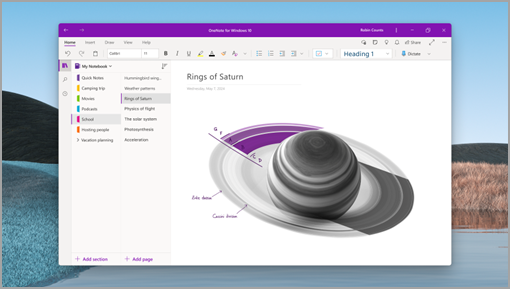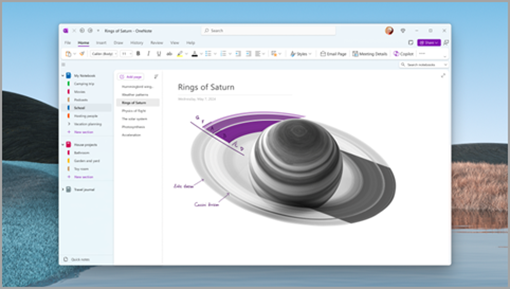OneNote on Windows is now the primary and supported way to take notes on your Windows PC. It offers a modern, customizable design, powerful new features, and a consistent experience across devices. Learn more about what you can do with the upgraded OneNote on Windows here.
OneNote for Windows 10 has reached End of Support
As of October 14, 2025, OneNote for Windows 10 has officially reached End of Support (EOS) and will now transition into a read-only mode. This means:
-
You can still open and view your existing notes, but creating, editing, or syncing content is no longer supported.
-
The app no longer receives bug fixes, security updates, or technical support.
To continue creating and editing notes, please use the OneNote app for Windows, available in the Microsoft Store, if it is not already included on your device, to begin the process. After signing into the updated app and opening your selection of notebooks, you're done!
Important: If any notes haven't successfully synced on OneNote for Windows 10, they will not show up in OneNote on Windows. To ensure all your notes transfer over, please verify that all your notebooks in OneNote for Windows 10 are successfully synced.
When will the OneNote for Windows 10 app be replaced?
New Windows 11 devices no longer include OneNote for Windows 10, and the upgraded OneNote on Windows app is usually included as part of Microsoft 365 or can be installed as the default notetaking application, free for all to use. The OneNote for Windows 10 application will continue to be available via download from the Microsoft Store through the fall of 2025. On existing devices, such as Windows 10 devices or devices upgraded to Windows 11, users can get the upgraded OneNote on Windows by downloading it from the Microsoft Store.
How do I know which OneNote I'm using?
A way to check is to open the OneNote app and look for the File menu at the top of the application. If you see it, you have the upgraded OneNote on Windows. If you don't, you are using OneNote for Windows 10, also reflected in the title bar. We recommend switching to OneNote on Windows to enjoy the newest features and updates.
To learn more about the different versions of OneNote, check out this helpful article.
OneNote for Windows 10
OneNote on Windows
Discover the upgraded OneNote on Windows
The upgraded OneNote on Windows is the ultimate note-taking app for everyone. Whether you need to jot down ideas, organize projects, or express your creativity, you can do it all with OneNote on Windows. And the best part is, it's free. Here are some of the great new features that make OneNote on Windows stand out:
-
Microsoft Copilot helps you write clearer, more engaging notes, or summarize them.
-
Brand new ink tools – including the new Text Pen and Ink Gestures.
-
Loop Components let you embed interactive content from other apps (rolling out).
-
Voice Dictation and Transcription let you capture your thoughts and conversations.
-
Powerful search lets you find anything in your notes quickly and easily.
Tips and Tricks when switching to the upgraded OneNote on Windows
To ensure all your content appears in the upgraded OneNote on Windows, make sure to sync your OneNote content before you switch. To do this, right click on your notebook(s) and select, Sync Now. If there are any sync errors, be sure to resolve them before switching apps!
If your notebook has any misplaced or open sections, we encourage you to move those to a notebook and ensure they have successfully synced to avoid any loss of notes. To check this, navigate to View Tab > Misplaced Sections. From here, you can choose which notebook to file these notes in.
After migrating to OneNote on Windows verify all your notes are showing up correctly:
-
Ensure to open each notebook you previously had open on OneNote for Windows 10. Verify the contents to ensure all your notes synced to OneNote on Windows correctly.
-
If there are notes missing in OneNote on Windows, ensure they have successfully synced in OneNote for Windows 10 or copy them over to OneNote on Windows.
-
Only uninstall OneNote for Windows 10 once you've verified the notes appear as expected on OneNote on Windows. We recommend uninstalling OneNote for Windows 10 to ensure you're always using the correct version.
Check your account settings and ensure everything is up to date.
Frequently asked questions
Here are some common questions and answers about the migration process.
OneNote for Windows 10 is no longer included in Windows 11 versions as an inbox app. It is still available on the Store and will not be automatically removed if it is already installed. Once it reaches end of support on October 2025, it will become read-only and only people who had it previously installed will have access to it.
If you have unsynced changes or sync errors in OneNote for Windows 10, you can still recover them in OneNote on Windows. After completing the Migration, open OneNote on Windows, go to File > Options > Save & Backup to locate your Backup Folder, and open it in File Explorer. Each .one file is a section, double-click to open it, then right-click to Move or Copy it into your notebook. Repeat until all sections are restored. More details here.
If you run into issues when backing up your notes, please leverage this guide here.
Absolutely! If the fonts or spacing feel too tight, go to File > Options > General > Optimize for compatibility and restart OneNote. Your fonts and spacing will return to the familiar layout you’re used to.
Yes, installing or using the upgraded OneNote on Windows app will not replace or remove OneNote for Windows 10 for you. So, you can switch back to OneNote for Windows 10 if you need to. However, we do not recommend doing so, as you will miss out on the new features and improvements in OneNote for Windows, and you will have to migrate again before the end of support date.
Additionally, features and functionality in OneNote for Windows 10 may be deprecated. To avoid any disruptions, we recommend switching to use OneNote on Windows at your earliest convenience.
No, you will not lose any data during the migration. All your cloud-saved notebooks, sections, pages, notes, tags, ink, attachments, and other content will be preserved and accessible in OneNote on Windows unless you have unsynced changes or sync errors. If you have notes or attachments that are not saved to the cloud, we recommend you sync those to your cloud notebooks prior to migration. Any notes not synced to the cloud will not show up in OneNote on Windows.
You will be able to sign into multiple accounts on OneNote on Windows, as well. If you have multiple accounts in OneNote for Windows 10, just make sure to sign into them on OneNote on Windows. All your notes will be available after you sign in if they have been successfully synced to a cloud notebook.
Note: Uninstalling the app will delete any local data associated with it. Please make sure that there are no sync errors and that all your notes are properly synced to the cloud before proceeding, otherwise, any changes that are locally saved may be lost.
Once you have confirmed that all of your notes are showing as expected on OneNote on web or the OneNote app, you can uninstall OneNote for Windows 10.
Go to Settings > Apps > Installed apps. Find OneNote for Windows 10. Select … -> Choose Uninstall.
If you have any other questions or issues with the migration process, you can contact us through our support page or directly in the OneNote app by clicking the support icon (if this option is available to you).
Thank you for using OneNote and we hope you enjoy the upgraded OneNote on Windows!
Download the OneNote on Windows app here.












